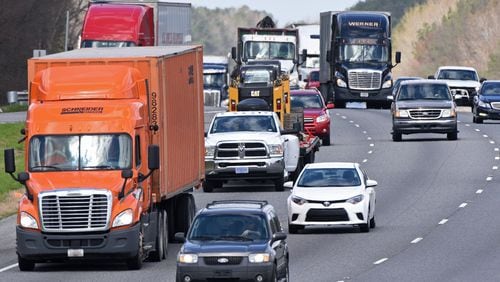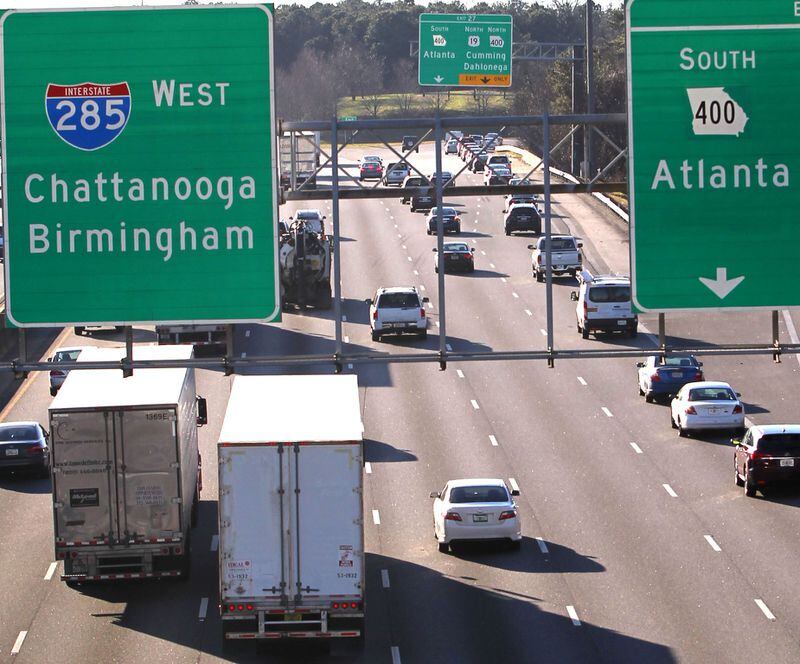MORE TRUCKIN’
The Atlanta Regional Commission predicts a 76 percent increase in the amount of freight travelling around the region by 2040. Here’s what the trucks carry today:
— Stuff delivered from warehouses and distribution centers — 25 percent
— Non-metallic minerals — 23 percent
— Petroleum or coal products — 11 percent
— Clay, concrete, glass or stone — 10 percent
— Foodstuffs — 9 percent
As if traffic isn’t bad enough, drivers might see almost twice as many freight-hauling trucks on metro Atlanta roads in 25 years.
Ever-worsening congestion will further frustrate commuters. But the surge in freight traffic poses even greater threats to Atlanta businesses.
Will Kroger be able to supply fresh broccoli to intown stores daily? Will the region’s manufacturing surge disappear? Will warehouses and distribution centers close? Will Amazon deliver packages within four hours?
Atlanta is expected to add 2.5 million people and 1 million jobs by 2040. It could also witness a 76 percent increase in freight traffic, the Atlanta Regional Commission says.
“If we don’t do anything,” said Ed Crowell, president of the Georgia Motor Trucking Association, “we will choke on our own success and success will move elsewhere.”
Crowell, though, isn’t pessimistic. He served on the ARC task force that recently unveiled future freight prospects and solutions.
The so-called Freight Mobility Plan envisions cementing Atlanta’s reputation as the distribution hub of the Southeast while ensuring that a cargo boom won’t strangle the region’s economy. It also calls for spending $1.8 billion to fix current traffic bottlenecks.
“It will be a different region in 2040 with many more people, but we’ll adapt,” said Daniel Studdard, freight planner for the ARC. “We’ve got to go ahead and plan for that now so, from a transportation perspective, we won’t be overwhelmed.”
Population and location made Atlanta the logistics capital of the South. Trucks, trains and planes supply the region’s 5.5 million consumers. Three interstate highways, two major rail lines and hundreds of trucking companies ensure goods flow from the port of Savannah through Atlanta to the Southeast and Midwest.
Metro Atlanta’s population ranks as the nation’s ninth largest, yet the region is No. 4 in industrial space, according to CBRE Research. The freight industry, and ancillary services, contribute nearly $200 billion annually to the region’s economy, according to the ARC.
Credit: Hyosub Shin
Credit: Hyosub Shin
The port of Savannah, increasingly, fuels Atlanta’s freight traffic. Nearly half of the the region’s imports come by truck — 70,000 truckloads a year — from Savannah. The container port is the second busiest on the East Coast. A newly expanded Panama Canal, which allows larger ships to travel between Asian manufacturing hubs and the Eastern seaboard, could bring more truck traffic to Atlanta.
In all, more than 150 million tons of freight move through and within Metro Atlanta annually; more than three-fourths of the cargo travels by truck. By 2040, according to the ARC, an estimated 266 million tons will ply Atlanta’s highways, byways and rail lines.
Construction a driver
Construction — clay, sand, concrete, glass, stone and other building materials — materials account for one-third of the region’s truck traffic. Deliveries from warehouses account for one of every five truck movements.
“E-commerce is going to grow. More and more millenials won’t go into a store if they can help it,” said Chitra Subbarayan, a vice president with real estate firm Ackerman and Co. “We are so dependent on the movement of goods. It’s inconceivable for us to come home and not find the food we like in our fridges.”
Amazon, Walmart and Home Depot have all opened huge distribution centers in recent years while adding hundreds of trucks daily to local roads. Two years ago Home Depot opened a “direct fulfillment center” to handle online orders in Locust Grove off an already congested I-75.
Henry County is fast becoming a “freight cluster” with a multitude of warehouses. It is also conveniently located allowing drivers to run back and forth to the port of Savannah in one shift. Its population is expected to double to more than 400,000 by 2040, adding thousands of cars to a truck-saturated interstate near McDonough.
“A lot of those distribution centers have a shift change at 3 or 4 p.m. (and) you add that to the truck traffic moving up and down the interstate and, suddenly, you get traffic congestion in the mid- to late-afternoon,” said the ARC’s Studdard. “Then you get the regular evening rush hour which doesn’t clear up until 7 p.m.”
Identifying bottlenecks
Studdard, Subbarayan and Crowell joined other business, government and nonprofit officials to identify freight bottlenecks and propose traffic-flow remedies. The major obstacles, not surprisingly, included: the entire top end of I-285; I-20 on both sides of town; and I-75 South, particulary in Henry County. One task force member said that “I-85 South is the only good corridor left.”
The task force recommends $1.8 billion “in carefully targeted road and highway improvements” to be undertaken by 2021. The major bottlenecks should be tackled with new lanes, interchanges or road realignments. It also singles out I-85 at Senoia Road, I-75 and Forest Parkway and State Road 92 in Douglas County for special attention.
The list largely mirrors Gov. Nathan Deal’s “strategic” freight plan unveiled earlier this year and other state traffic improvement plans. The report helps make the case for additional federal transportation dollars too.
Nobody can predict freight or traffic patterns 25 years out. The economy could tank. Consumer preferences may change. Diesel or electricity costs could skyrocket. And technology promises to revolutionize freight shipments with truck-only lanes, driverless vehicles, “intelligent” lanes and other developments streamlining the delivery of commodities and consumer goods.
Studdard, though, says Metro Atlanta can’t rest on its logistical laurels.
“We can’t wake up in 2040 and say, ‘What happened?” he said.
About the Author







